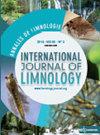巴尔干半岛泉水系统和其他小水体中手蛾科(双翅目)的多样性
IF 0.9
4区 环境科学与生态学
Q4 LIMNOLOGY
Annales De Limnologie-international Journal of Limnology
Pub Date : 2023-01-01
DOI:10.1051/limn/2023005
引用次数: 0
摘要
已知手摇蝇科发生在小的,甚至是不稳定的水体中,如渗漏,流变,水池和井。巴尔干半岛显示出小水体的高度可变性,泉水(流变、limnocrens和helocrens)分布最广泛。本文简要介绍了山谷、山地小水体以及斯卡达尔湖(Shkodra)泉水系统中的摇尾蝇科群落。河谷提供了种类繁多的小型淡水栖息地。它们的存在极大地增加了摇蚊科蠓的多样性,为江河湖泊中不存在的冷热生物和半陆生物提供了栖息地。小水体的物种丰富度在很大程度上取决于其水文条件(即多年生水体与静态水体)、大小和微生境复杂性。山泉群落依赖于降水,表现出高度分带性。海拔较高的山区(海拔1400-1500米)由于常年稳定的水文条件,蠓类组合最多样化。人类活动可能会改变河岸泉水的物种组成,有利于对当地动物群来说不是典型的分类群。通过对这些小型水生栖息地的研究,人们认识到了它们的Chironomidae动物群的重要性,从而填补了巴尔干地区淡水昆虫生物多样性知识的空白。本文章由计算机程序翻译,如有差异,请以英文原文为准。
The Chironomidae (Diptera) diversity in the Balkan Peninsula spring systems and other small water bodies
Chironomidae are known to occur in small, even astatic water bodies like seepages, rheocrens, pools and wells. The Balkan Peninsula reveals a high variability of small water bodies, with springs (rheocrens, limnocrens and helocrens) being the most widely distributed. In this review, we give a brief presentation of the Chironomidae communities in valley and mountain small water bodies, and in Lake Skadar (Shkodra) spring system. River valleys offer a large variety of small freshwater habitats. Their presence strongly increases of midge (Chironomidae) diversity, providing a habitat for the cold-stenotherms and semiterrestrial taxa that do not occur in rivers and lakes. The species richness in small water bodies strongly depends on their hydrological conditions (i.e. perennial vs. astatic water bodies), size and microhabitat complexity. Mountain spring communities depend on precipitation and exhibit altitudinal zonation. The higher mountain zones (1400–1500 m a.s.l.) have the most diverse midge assemblages, due to their stable perennial hydrological conditions. Human activity may alter species composition in riparian springs, favouring taxa that are not typical to the local fauna. By studying these small aquatic habitats, the significance of their Chironomidae fauna is being recognised, thereby filling a gap in the knowledge of freshwater insects biodiversity in the Balkan region.
求助全文
通过发布文献求助,成功后即可免费获取论文全文。
去求助
来源期刊
CiteScore
2.20
自引率
0.00%
发文量
0
审稿时长
>12 weeks
期刊介绍:
Annales de Limnologie - International Journal of Limnology publishes papers on the ecology of freshwater systems, ranging from studies of aquatic organisms, physical and chemical works which relate to the biological environment, to ecological applications and frameworks for water management directives.
Main topics: Ecology of freshwater systems ; biodiversity, taxonomy, distribution patterns in space and time, biology of animals and plants ; experimental and conceptual studies which integrate laboratory and/or field work on physiology, population dynamics, biogeochemistry and nutrient dynamics, management, mathematical modelling ; techniques for sampling and chemical analyses, ecological applications, procedures which provide frameworks for environmental legislation.

 求助内容:
求助内容: 应助结果提醒方式:
应助结果提醒方式:


